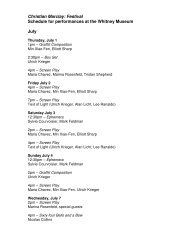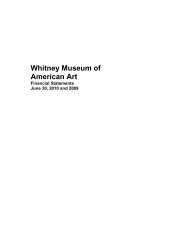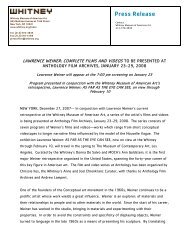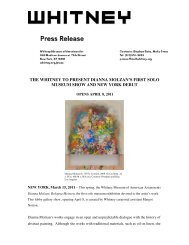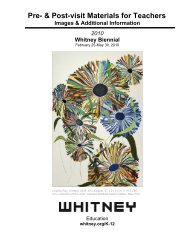Press Release - Whitney Museum of American Art
Press Release - Whitney Museum of American Art
Press Release - Whitney Museum of American Art
Create successful ePaper yourself
Turn your PDF publications into a flip-book with our unique Google optimized e-Paper software.
Alice Guy Blaché (the name she chose to use after her divorce and return to France in 1922)<br />
produced a singular body <strong>of</strong> work that spans the evolution <strong>of</strong> filmmaking on two continents.<br />
Her oeuvre in both her French and <strong>American</strong> periods reveals her to have been a gifted<br />
scriptwriter who transformed imagined picture-stories into motion pictures and a new kind<br />
<strong>of</strong> director who asked actors to “be natural.” She established the house style at Gaumont,<br />
trained its next generation <strong>of</strong> directors (including Ferdinand Zecca, Etienne Arnaud, Louis<br />
Feuillade), and then did the same at her US company, Solax. Her role as a studio owner is<br />
still rare in the film industry; among the few women who followed her were Mary Pickford<br />
and Lucille Ball.<br />
Although her moviemaking career ended in 1920, when she was only forty-seven years old,<br />
cinema occupied her whole life. She corresponded with historians and others, sharing<br />
documents with them, to correct early film histories that had not included her work. Well<br />
into her eighties, she gave lectures and was interviewed on radio and television about her<br />
roles in the nascent film industries <strong>of</strong> the US and France. In 1955, she was recognized with<br />
the Legion <strong>of</strong> Honor (France’s highest non-military honor), and in 1957 was honored by the<br />
Cinémathèque Française. The posthumous publication <strong>of</strong> her memoirs, first in French in<br />
1976 and then in English in 1986, with the assistance <strong>of</strong> film historian Anthony Slide,<br />
initiated an important cycle <strong>of</strong> rediscovery. In his catalogue essay, film historian Alan<br />
Williams calls Blaché’s memoirs “one <strong>of</strong> the very best books <strong>of</strong> its kind…a basic text in the<br />
history <strong>of</strong> early cinema.”<br />
This exhibition underscores the importance <strong>of</strong> film preservation in the study <strong>of</strong> early<br />
cinema. From the <strong>American</strong> portion <strong>of</strong> Madame Blaché’s career, five films that are in the<br />
collection <strong>of</strong> the Library <strong>of</strong> Congress have been restored by the <strong>Whitney</strong>, including the<br />
feature The Ocean Waif. Two others, also in the collection <strong>of</strong> the Library, have been<br />
restored by gift: Falling Leaves (1911), thanks to Dayton Digital Filmworks, and Mixed Pets<br />
(1911), with a grant from New York Women in Film and Television, Women’s Film<br />
Preservation Fund and contributions by the <strong>Whitney</strong>. The occasion <strong>of</strong> this exhibition has<br />
been the catalyst for other archives to begin to restore films in their collections, including<br />
the Academy Film Archive-Center for Motion Picture Study, Los Angeles; BFI, London; and<br />
the Filmoteca Española, Madrid.<br />
Detailed daily screening information will be available on whitney.org. To<br />
accommodate requirements for limited screenings <strong>of</strong> archival film material and also allow<br />
wider access to these films, for the twelve Sundays and select Friday evenings during the<br />
exhibition’s run, special 35mm projections will take place, many <strong>of</strong> them with live musical<br />
accompaniment. The weekly screenings will be shown in other formats, including beta-sp<br />
and HD. A selection <strong>of</strong> Guy’s synchronized sound films will be screened and heard; several<br />
suites <strong>of</strong> silent films will be accompanied by recorded scores by contemporary composers<br />
Du Yun, Missy Mazzoli, Tamar Muskal, and Tender Forever—commissioned by <strong>Whitney</strong> Live<br />
and the French Institute Alliance Française—and by Barbara Harbach.<br />
Catalogue<br />
The <strong>Whitney</strong>’s exhibition <strong>of</strong> the films <strong>of</strong> Alice Guy Blaché is accompanied by an illustrated<br />
catalogue (fifty-nine black-and-white images; eight-page color section) published by Yale<br />
University <strong>Press</strong>, in association with the <strong>Whitney</strong> <strong>Museum</strong> <strong>of</strong> <strong>American</strong> <strong>Art</strong>, with<br />
contributions by noted film scholars Jane Gaines, Alison McMahan, Charles Musser, Alan




